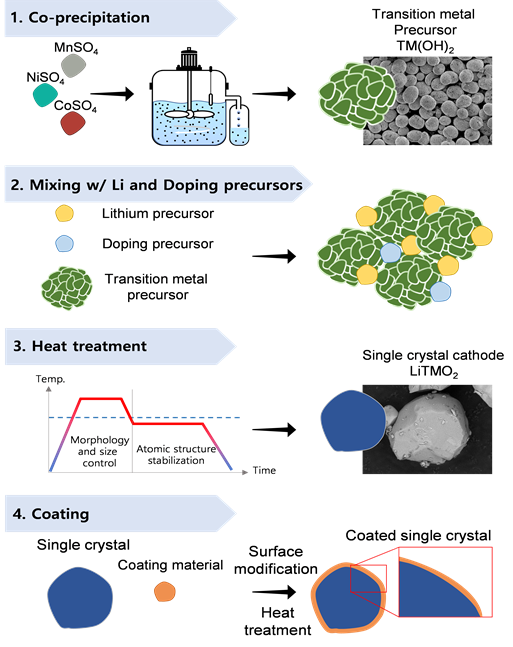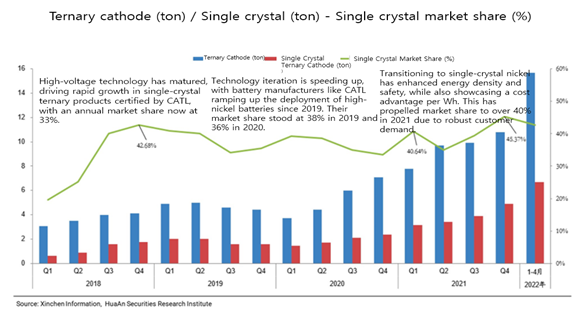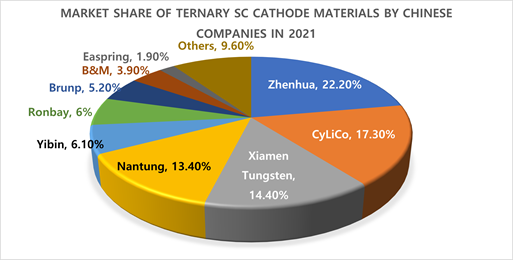<2023> Single Crystal (Single Particle) Cathode Technology Development Trend and Market Outlook
The mass production of single-crystal cathodes, poised to significantly enhance electric vehicle battery performance, is imminent, heralding an anticipated escalation in competition between Chinese and Korean companies.
In commercial electric vehicle batteries, the cathode materials currently employed consist of polycrystalline structures comprising multiple metal compound crystals. However, cracks often develop between these particles during the rolling process to achieve uniform thickness, as well as during charging and discharging. With repeated cycles, these cracks expand, resulting in material deterioration, increased gas generation within the battery, and a decline in charging/discharging cycles, ultimately diminishing battery longevity.
Single crystals, unlike their polycrystalline counterparts, are immune to this issue as their particles remain intact. Moreover, as nickel content rises to boost capacity, structural stability decreases, heightening the risk of fire. Hence, the development of single crystal cathodes emerges as a solution to this challenge.
Single crystal cathodes offer cost savings and enhanced yields by eliminating residual materials, thereby lowering defect probability and obviating the need for a washing process. This step, crucial in cathode manufacturing for impurity removal, becomes unnecessary with single crystal technology.
The commercialization of single-crystal cathodes is poised to broaden the utilization of high-nickel cathodes. With reduced gas generation, battery lifespan extends while accommodating more active material, boosting energy density. Implementing this in electric vehicle battery packs could enable over 500 km of driving range on a single charge with fewer cells, facilitating longer-range vehicle models. This potential game-changer promises both cost reduction and performance enhancement simultaneously.
Yet, single crystal cathodes also pose drawbacks. Unlike polycrystalline counterparts, large single crystal materials exhibit high initial resistance, challenging the application of desired voltage. Consequently, output remains low, impeding battery performance enhancement.
However, single crystal cathodes entail extra processing steps and operate at higher voltages, potentially raising battery temperatures. Moreover, single crystal particles are susceptible to damage during the calendering process, a crucial part of electrode manufacturing.
Consequently, in the initial stages of mass production, single crystals are likely to be blended with polycrystals rather than being produced in their pure form.
Chinese companies are already producing single crystal cathodes for NCM523 and 622, and domestic companies such as LG Chem, Ecopro BEM, L&F, and POSCO FutureM have also completed development and are conducting quality tests with clients. The targets are single crystal NCA and NCM, and it can be seen that they are ready for mass production.
Industry experts anticipate that the performance and quality of single crystal cathodes will hinge on coating technology to ensure durability and the manufacturing process of single crystals. Essentially, the focus lies in effectively conducting surface treatment while simultaneously augmenting particle size.
Currently, the market for mass-produced single crystal cathodes is dominated by the top 5 Chinese companies, which account for about 75% of the total market.
According to announcements by Korean cathode material companies, SNE Research predicts that they will start supplying samples this year (2023) and produce more than 120,000 tons in 2025. Currently, in the case of Chinese ternary single crystal cathodes, the proportion of 5 series single crystals, such as NCM 523, is the highest at 60% to 70%. The proportion of 6 series single crystals, such as NCM622, is 18 to 25%. In the case of 8 series with a Ni content of 80% or higher, the production ratio has increased since 2021 and currently accounts for about 15%. This proportion is expected to continue to increase.
According to SNE Research, it is difficult to predict the market for Korea at this time because there is no data on production volume by Ni content. However, in the case of China, Hi-Ni is expected to be about $4.2 billion and Mid-Ni is expected to be $9.2 billion in 2025. In 2030, Hi-Ni is expected to be about $24 billion and Mid-Ni is expected to be $23.8 billion, so the market for Hi-Ni is expected to be larger.
Strong Points of this report
① Cover fundamental and advances in the development of single-crystal Ni-rich cathode materials
② Include a very detailed study of research trends and future prospects for single-crystal Ni-rich cathode materials.
③ Include content on research regarding the capacity degradation mechanism of single-crystal Ni-rich cathodes.
④ Compare major synthesis methods for single-crystal NCM cathode materials
⑤ Detailed recent developments and patent analysis of single-crystal cathode material manufacturers
⑥ Market outlook for single-crystal cathode materials
[Schematic diagram of general single-crystal Ni-rich layered cathode material synthesis and additional modification process]



Table of Contents
1. Overview of Cathode Materials 11
1.1. History of Cathode Material Development 11
1.2. Recent Trends in Cathode Materials 12
1.2.1. Layered Oxide Cathode Materials 12
1.2.2. Spinel Oxide Cathode Material 13
1.2.3. Polyanionic Oxide (PAO) Cathode Materials 14
1.3. Development Status of Cathode Materials by Type 15
1.3.1. Microstructure Modification 16
1.3.2. Removal of Cathode Cracks 17
1.3.3. Application of the One-Pot process 18
1.3.4. Microwave Processing 19
2. Research Trends and Future Prospects of Single Crystal Ni-rich Layered Cathodes 20
2.1. Need for Research on Single Crystal Ni-rich Layered Materials 21
2.1.1. The Need for Ni-rich Layered Materials (Advantages) 21
2.1.2. Degradation Mechanisms of Ni-rich Layered Cathode Materials 24
2.1.3. Need for Single Crystallization (Monoparticulation) of Ni-rich Layered Cathode Materials 27
2.2. Definition of Single-crystal Cathode Material 28
2.3. Development Status of Single-crystal Cathode Material Technology 28
2.3.1 Single-particle Ni-rich Layered Material Synthesis Research 29
2.3.2 Research on Sintering Methods for Synthesis of Single-particle Ni-rich Layered Materials 35
2.3.3. Study on Modifying Materials to Enhance Performance of Single-particle Ni-rich Layered Materials 42
2.3.3.1 Surface Coating Research 42
2.3.3.2. Elemental Substitution Study (Doping) 45
2.3.3.2.1. Single Doping 46
2.3.3.2.2. Dual Doping 48
2.3.3.3. Electrolyte Optimization 48
2.3.4. Utilization Strategies for Single-Crystal Ni-Based Layered Materials 49
2.3.4.1. Advantages of Single-Crystallization in Ni-Based Layered Cathodes for Electrode Design 50
2.3.4.2. Disadvantages of Single-Crystallization in Ni-Based Layered Cathodes for Electrode Design 51
2.3.4.3. Research on Addressing Challenges in Single-Crystallization of Ni-Based Layered Materials 52
2.4. Improvement Through Material Single-Particle Formation 53
2.4.1. Mitigation of Particle Breakage Characteristics 53
2.4.4.1. Pressing Stage in Electrode Manufacturing 53
2.4.2. Particle Breakage During Charge-Discharge Processes 53
2.4.3. Quantitative Reduction of Surface Degradation through Reduced Specific Surface Area 54
2.4.4. Energy Density Increase 56
2.4.5. Washing Process Omission 57
2.5. Limitations of Current SC Cathode Material Technology Development and Research for Overcoming Them 58
2.5.1. Degradation of Material Crystal Structure Due to Difficulties in Optimizing Synthesis Conditions 58
2.5.2. Particle Size Limit 60
3. Single-Crystal Ni-Based Cathode Materials: Fundamentals and Advances 62
3.1. Overview 62
3.2. Ni-based Cathode Materials 64
3.2.1. Chemical Structure 64
3.2.2. Electronic Structure 66
3.3. Challenges of Ni-based Layered Oxides 67
3.3.1. Synthesis Difficulties 67
3.3.2. Structural Instability 70
3.3.3. Chemical Instability 71
3.3.4. Mechanical Performance Degradation 74
3.3.5. Safety Issues 76
3.4. Origin of Single-Crystal Ni-Based Layered Oxides 77
3.5. Synthesis of Single-Crystal Ni-based Layered Oxides 82
3.5.1. Synthesis Methods 82
3.6. Comparative Study of Single-Crystal and Polycrystalline Materials 93
3.7. Recent Advances in Single-Crystal Ni-Based Cathode Materials 96
3.7.1. Doping and Surface Coating 96
3.7.2. Mechanical Research 97
3.8. Results and Conclusion 101
4. Study of Capacity Fading Mechanism of Single-crystal Ni-rich NCM Cathode 102
4.1. Overview 102
4.2. Assessment of Fundamental Properties in Ni-rich Single-crystal and Polycrystalline Cathodes 103
4.2.1. Single-crystal and Polycrystalline Cathode Synthesis 104
4.2.2. Composition and Analysis of Single-crystal and Polycrystalline Cathodes 105
4.2.3. Electrochemical Properties of Single-crystal and Polycrystalline Cathodes 107
4.2.4. Structural Stress Analysis of Single-crystal and Polycrystalline Cathode Materials 110
4.2.5. In-situ XRD Analysis of Single-crystal and Polycrystalline Cathodes 113
4.2.6. TEM Analysis of Single-crystal and Polycrystalline Cathode Materials 116
4.2.7. Results and Conclusions 118
5. Particle Control of Ni-rich Monocrystalline Cathode Materials (Application of Sintering Process) 119
5.1. Overview 119
5.2. Experiment Description 120
5.3. Experimental Results 120
5.3.1. Optimization of Sintering Additives for Promoting Crystal Growth 120
5.3.2. Crystal Growth Mechanism 121
5.3.3. Ni-rich Structure of a Single Crystal Cathode 123
5.3.4. Performance of Ni-rich Single Crystal Cathodes 127
5.4. Application Results of Sintering Treatment 133
6. All-Dry Synthesis of Single-Crystal NMC Cathode Materials 134
6.1. Overview 134
6.2. Dry Synthesis 137
6.3. Dry Synthesis Results and Discussion 138
6.3.1. Precursor Structure and Morphology 138
6.3.2. Effect of Sintering Conditions on NMC Formation 140
6.3.3. Single-crystal NCM from Ball-milled Precursors 143
6.3.4. Conclusion 147
7. One-Spot Synthesis of Single Crystal NCM523 Cathode Material 148
7.1. Overview 148
7.2. Synthesis of NCM523 150
7.3. Characterization of Materials 150
7.4. Electrochemical Properties 151
7.5. Experiment Results and Discussion 151
7.5.1. Cathode Material Synthesis Product Analysis 151
7.5.2. Electrochemical Properties of Cathode Materials 156
7.5.3. Conclusion 158
8. Synthesis and Modification of Single-Crystal NCM Cathode Materials:Growth Mechanism 160
8.1. Overview 160
8.2. Growth Mechanism for NCM Cathodes 161
8.3. Solid State Reaction 163
8.4. Solid–Liquid Rheological Reaction 164
8.5. Crystal Growth in Molten Salt Flux 165
8.6. Modification of morphology 166
8.6.1. Control of Shape 166
8.6.2. Facet Control 167
8.6.3. Conclusion 168
9. Development of Single-Crystal Cathodes: DOE Program 169
9.1. Ultrafast Hydrothermal Synthesis of Ni-rich Single-Crystal Cathodes 169
9.2. Scaling up of High Performance Single Crystalline Ni-rich Cathode Materials with Advanced Lithium 174
9.3. Single-Crystal Cathodes for High-Performance All-Solid-State LIBs 176
10. Patent Analysis of Single Crystal Cathode Material Companies 180
10.1. Tesla 180
10.2. LG Chem 183
10.3. SM Lab 188
10.4. Nano One Materials 192
10.5. POSCO Future M 196
10.6. COSMO Advanced Materials & Technology 200
10.7. L&F 206
10.8. Easpring 209
10.9. BASF Shan Shan 211
10.10. GEM 214
10.11. XTC (Xiamen Tungsten) 217
10.12. Henan Kelong 221
10.13. Hyundai Motor Company / Kia Corporation 224
10.14. 6K Inc. 226
10.15. Dynanonic 229
10.16. Suzhou Long Power 231
10.17. Fengchao Energy 235
10.18. Ecopro BM 238
10.19. Umicore 240
11. Single-Crystal Cathode Material Industry Trends 243
11.1. LG Chem 251
11.2. POSCO FutureM 253
11.3. EcoPro BM 257
11.4. Zhenhua E-Chem(ZEC) 258
11.5. Chanyuan Lico 264
11.6. Ronbay 270
11.7. XTC (Xiamen Tungsten) 276
11.8. Tianjin B&M 281
11.9. Easpring 286
11.10. Reshane 294
11.11. Yibin Libode 298
11.12. Wanxing 123 301
11.13. GEM 305
12. Single Crystal Cathode Market Outlook 313
12-1. 2017~2022H1 China Single Crystal Production Volume 317
12-2. 2019~2022.04 Production Volume and Share of Single Crystal Cathode Materials in China 318
12-3. 2019~2022Q1 Distribution of production volume by SC ternary cathode materials in China 318
12-4. 2019~2022Q1 Share of production by ternary SC cathode material in China 319
12-5. 2019~2022Q1 Market Penetration by Ternary SC Cathode Materials in China 319
12-6. Market Share of Ternary SC Cathode Materials by Chinese Companies in 2021 320
12-7. Production Volume and Market Share of Ternary SC cathode Material Companies in China in 2021 320
12-8. Korea-China Ternary Single Crystal Production Forecast 321
12-9. Korean Ternary SC Cathode Material Mroduction Volume and Market Outlook 321
12-10. Percentage of Single-crystal Cathodes among Ternary Cathode Materials in China 322
12-11. Forecast of Production Volume Ratio by Chinese Ternary Single Crystal Cathode Material 322
12-12. China Market Forecast by Ternary Single Crystal Cathode Material 323
References 323

